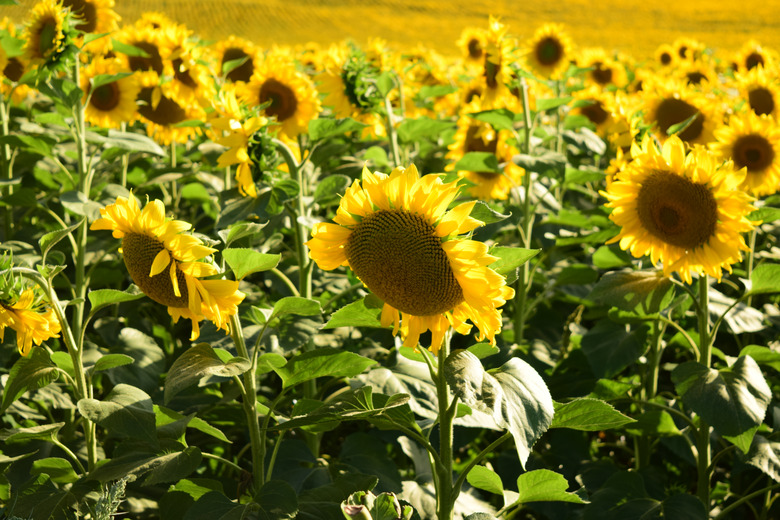What To Do When A Sunflower Dies
We may receive a commission on purchases made from links.
From the towering Mammoth Russian to the multi-branched, red-flowered Moulin Rouge, annual sunflowers (Helianthus annuus) are bright ambassadors of sunny summer afternoons. When fall rolls around, however, the leaves die, the stalks brown and a top-heavy stalk sits awkwardly in your landscape. When the sunflower dies, grab a sturdy pair of gloves, pruners and a shovel to prepare your garden for the next season.
Harvest the Seeds
Harvest the Seeds
If you planted a giant sunflower, do not forget to harvest the seeds before the birds do it for you. The leaves along the stalk may still be green; they start their end-of-season decline after the yellow petals surrounding the seed-heavy head are dead or have already dropped. Cut the stem roughly 12 inches from the head when the back of the head is a golden yellow or brown, the petals are dead and the seeds are plump. Hang the head in a sheltered, dry area, and then knock the loosened seeds into a container to fully dry.
Monitor for Diseases
Monitor for Diseases
Unfortunately, disease may kill your sunflowers before their time. Downy and powdery mildew — fungi that form silver, dusty patches on leaves and stems — do not usually cause severe damage. Verticillium wilt and sclerotinia head rot, however, wilt your sunflowers, form dead patches on the leaves or stems and may affect nearby plants. If a sunflower dies from disease, pull it immediately and dispose of it in the trash. Never compost diseased sunflowers.
To prevent the spread of diseases and pests, always sterilize your cutting tools by dipping the blades or wiping them in rubbing alcohol or a household cleaner like Lysol. Avoid using chlorine bleach solutions; bleach pits and corrodes the metal blades. Also put on gloves, long sleeves and safety goggles to protect your skin and eyes from the prickly stems, dried leaves and plant debris.
When a Sunflower Dies
When a Sunflower Dies
Once your annual sunflower dies, simply uproot the plant and knock off excess dirt from the roots. Sunflowers, especially the taller varieties, usually form a single taproot and a thick mat of side roots.
Dry, mid-sized plants will not put up much of a fight, but larger plants may cling tenaciously to the ground; water the area before pulling to soften the soil. If your sunflowers have a single, woody stalk, do not wrestle with it. Instead, grip the top of the stalk and pull sideways, using leverage to pry the base from the ground. If it still resists, use a garden shovel to loosen the soil around the roots before giving the stalk a good pull.
Considerations When Cleaning the Garden
Considerations When Cleaning the Garden
Wear gloves when handling the dead sunflower stalks. In addition to the small spines that cover the stalks, if red ants or wasps frequent your garden, be wary. Ants and wasps often farm honeydew from aphids hidden on the underside of the sunflower's broad leaves.
Remove, chop up or shred any large, tough stalks before adding dead sunflowers to your compost pile. The stalks do not break down easily and become a nuisance. Also rake up dead leaves and other garden debris and put it on the compost pile. Alternately, rake and turn over the plant debris several times in fall, winter and spring to expose insect pests to hungry birds.
